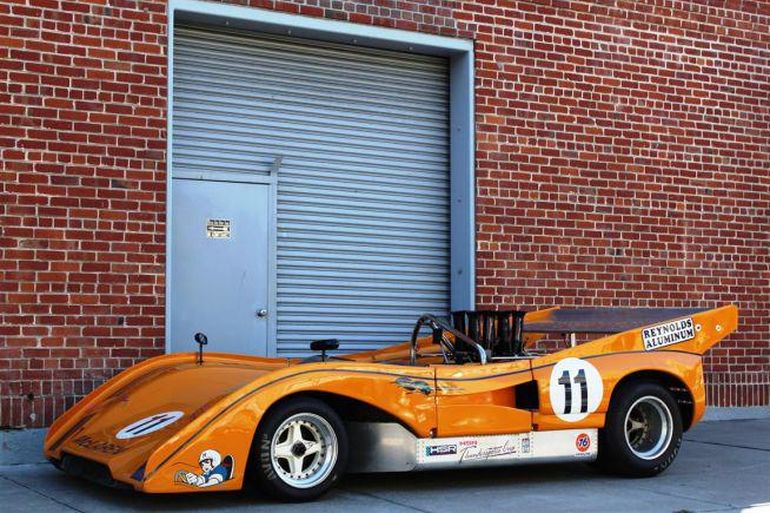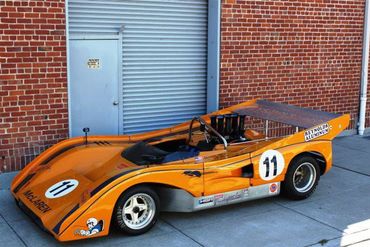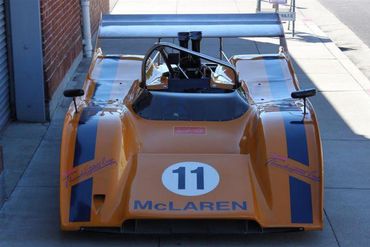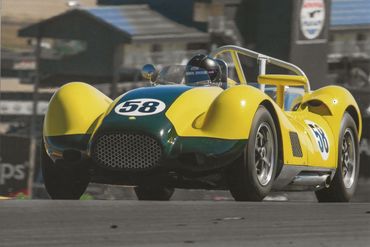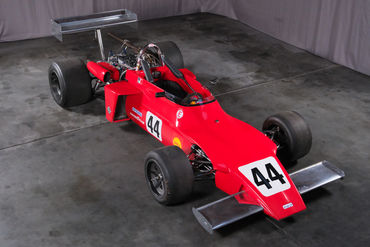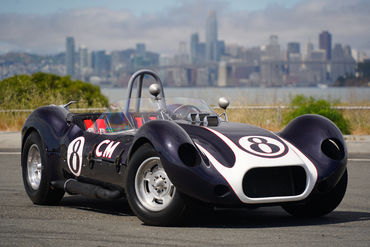Sold
SOLD 04/14
1972 McLaren
M8E/F
Exciting, Cost Effective Entry to Premier North American Vintage Racing Venues.
- VIN
- Exterior ColorPapaya Factory Livery
- Interior Color
- MileageTMU
- Engine510 c.i. 8-Cylinder
- TransmissionLG-600 5-Speed
- StatusSold
- StockFJ1472
Description
1972 McLaren M8E/F
Ex-Benton Bryan
Papaya Factory Livery
The Canadian American Challenge Cup series was a unique experiment in almost complete freedom of design. So often in motorsports strict limitations imposed, but in the case of Can Am, just about anything went. Engines could be any displacement or design, with forced induction, outlandish aerodynamic aids, and even four wheel drive permitted. The resulting cars were very wild, and very fast, faster than even the contemporary Formula One cars, in fact.
McLaren`s own efforts were very successful in the series, amassing more victories than any other manufacturer (43) by the time the series ended in 1974. Their tremendous success began with their first monocoque car, the M6A of 1967. This car evolved into the M8A with the addition of a big block motor for 1968, and the M8B and M8D with further refinements for 1969 and 1970 respectively. The M8F was the ultimate development (aside from a pair of M20`s which were factory cars only and not available to the public) of McLaren`s successful Can Am cars, and featured a lengthened and strengthened chassis, 17-inch wide rear wheels, and revised aerodynamics. The intake stacks were staggered to smooth out the power delivery, and the combined effect of the 1520 pound curb weight and 8.3 liter engine were nothing short of spectacular, earning the moniker of “the ultimate laxative” as coined by the folks at Trojan Cars. Despite the massive displacement, the engine redlined at 7000 rpm, a remarkable feat for an engine with “pistons like flower pots” and “valves like umbrellas”, as characterized by Autosport Magazine.
This particular chassis is best described as a continuation car, having accumulated historic racing history between 1987 and 1999, often with period racer Vic Elford behind the wheel. The car has competed in a number of North American based Thundersports Series races, as well as a number of HSR and SVRA venues.
According to the sellers, the origins of the car may extend back to 1972, when a damaged chassis, from the 1972 racing season, likely s/n 80-04, was sold to Lindsey Hopkins, who sold it onward to Benton Bryan, who concurrently owned two cars at the time. Whatever the origins, the car in its current form came into being in the late 1980s, and the only confirmable competition history for this chassis has occurred after the mid-1980s. We have not been able to establish concrete connections between s/n 80-04 and this car, nor do we know of any specific ties to any factory efforts using this particular example, though it is painted to emulate the factory cars of the era.
As is the case with all M8 series cars, this example is constructed with an aluminum monocoque, cloaked in massive yet lightweight fiberglass bodywork. According to the sellers, this example is powered by a 510c.i. big block engine with Lucas injection, built by Keith Black. As told to us, the engine produced 900 horsepower on the dyno, and has dyno time only since being rebuilt. Power is fed through a Hewland transaxle bearing the identification number LG600-329 stamped on the rear cover.
Today, this example is best described as having fairly good racing cosmetics. The period graphics have been faithfully replicated and the aluminum monocoque appears to be in very good condition, having been recently polished so that it shines. The remainder of the chassis and mechanical components appear to be in good order as well, displaying very fine historic race car cosmetics, as well as some very remarkable engineering. On file we have records for minor works performed in recent years, including the installation of a new fuel cell and new safety belts in late 2012.
As this particular car’s history has always been North American based, it has never required FIA papers, and accordingly, none are on file at this time. Nonetheless, it remains eligible for entry to many of the world’s premier historic Can-Am venues; the Monterey Historic Reunion, the Wine Country Classic, as well as, among other events, the entire HSR calendar, as it has previously competed in with Vic Elford driving.
This car is an extremely rare opportunity to acquire an inexpensive example of the pinnacle privateer McLaren model, from a genuinely historic time. Never before or since have drivers, designers, or enthusiasts had such a free hand to fully explore the potential of the automobile, and these cars truly do represent a heroic and unrepeatable time period. This particular car, with its recent and thorough preparation, excellent cosmetic condition, importance, and rarity, is an extremely attractive way to pay homage to and recapture this important and exciting period.
Interesting trades considered.
The above vehicle information is complete and accurate to the best of our knowledge at the time it is posted to this website. Corrections or additional information is always appreciated. All advertised prices exclude government fees and taxes, any finance charges, any dealer document preparation charge, and any emission testing charge. Vehicles are subject to prior sale. All advertised to be true but not guaranteed. We assume no liability for errors or omissions.
Inquire About This Car
Fantasy Junction • 510-653-7555 • 1145 Park Ave, Emeryville, CA 94608
